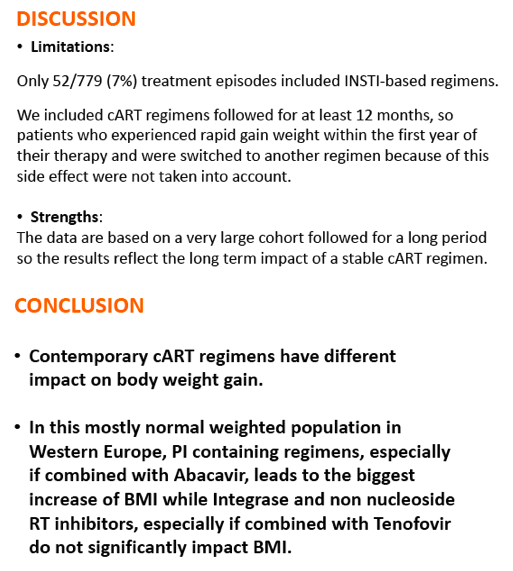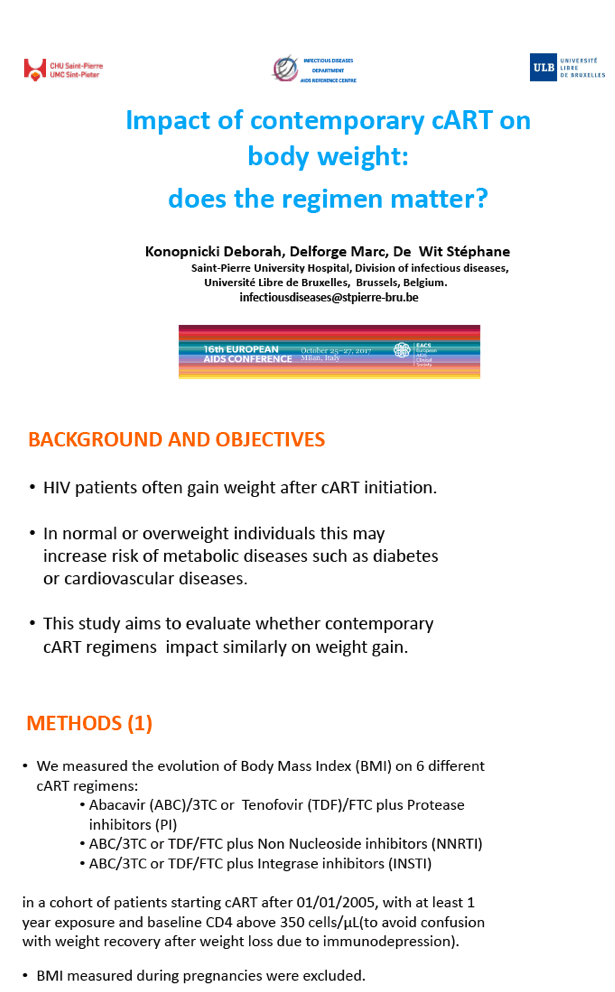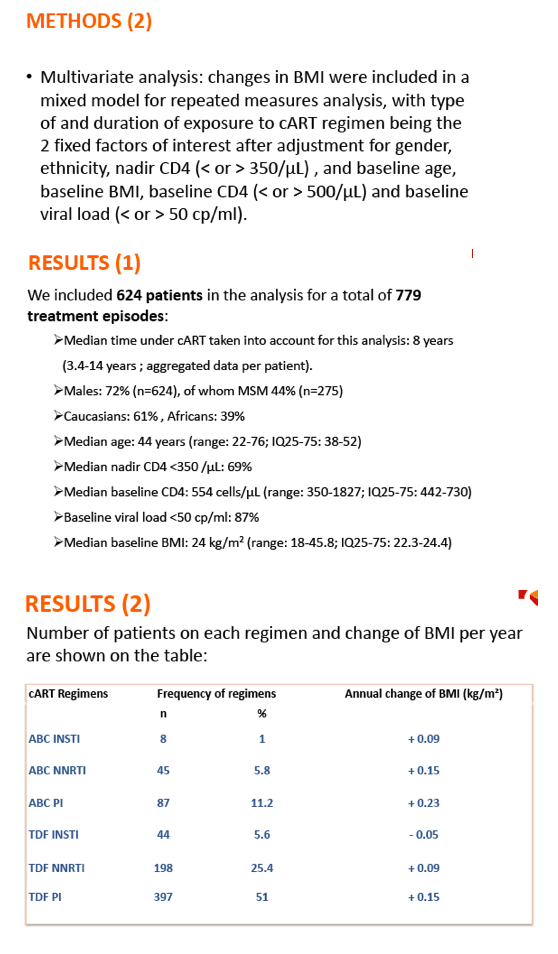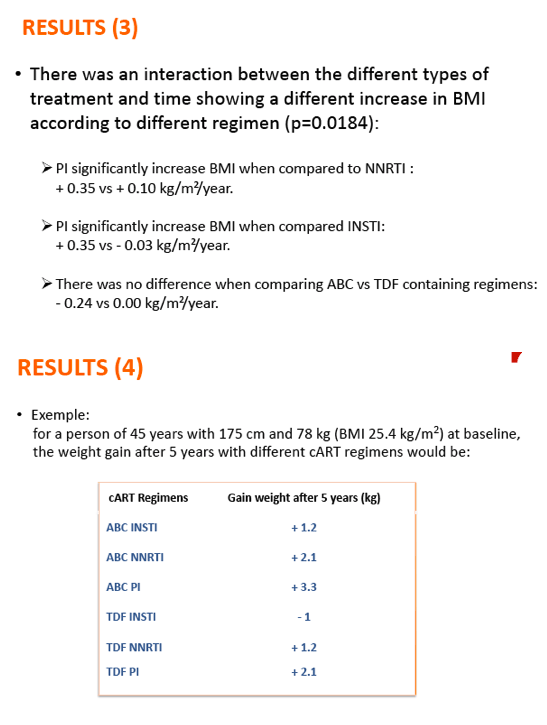 |
 |
 |
| |
Weight Gain & Affects of Different cART Regimens: PIs, NNRTIs, Integrase
|
| |
| |
Bigger Weight Gains With Contemporary PI Regimens Than With NNRTIs or INIs
16th European AIDS Conference, October 25-27, 2017. Milan
Mark Mascolini
People taking antiretroviral therapy (ART) with a protease inhibitor (PI) in a 624-person Belgian analysis gained more weight (measured as body mass index, BMI) than people taking a nonnucleoside (NNRTI) or an integrase inhibitor (INI) [1]. Weight change did not differ substantially by other drugs in the regimen--tenofovir/emtricitabine (TDF/FTC) or abacavir/lamivudine (ABC/3TC). But other recent studies of weight shifts with antiretrovirals produced divergent results [2,3].
HIV-positive people often gain weight when starting ART. In those at normal weight or already overweight, adding too many pounds poses risks of diabetes, cardiovascular disease, and other weight-related illnesses. To explore the impact of different contemporary antiretroviral regimens on weight change, researchers at Saint-Pierre University Hospital in Brussels conducted this retrospective analysis of adults taking currently standard antiretroviral regimens.
The study focused on people who started ART after January 1, 2005 and took one of six regimens for at least 1 year--ABC/3TC or TDF/FTC with either a PI, an NNRTI, or an INI. Everyone started a study regimen with a CD4 count above 350 (to avoid measuring healthy weight gains after loss due to low CD4 counts), and the analysis excluded BMIs measured during pregnancy. To compare weight changes with the different regimens, the Saint-Pierre team used a mixed model for repeated measure analysis with two fixed factors (regimen type and duration) while adjusting for gender, ethnicity, nadir CD4 count below or above 350, and baseline age, BMI, CD4 count below or above 500, and viral load below or above 50.
The analysis included 624 people with 779 treatment episodes. While 72% of participants were men, 44% were gay/bisexual men, 61% Caucasian, and 39% African. Median time on ART measured 8 years, median age 44 years, median CD4 count 544, and median baseline BMI 24 kg/m2 (interquartile range 22.3 to 24.4, overall range 18 to 45.8). Most people, 87%, reached a viral load below 50 copies.
Proportions taking each of the six regimens and annual change in BMI (kg/m2) were 1% and +0.09 for ABC/3TC + INI, 5.8% and +0.15 for ABC/3TC + NNRTI, 11.2% and +0.23 for ABC/3TC + PI, 5.6% and -0.05 for TDF/FTC + INI, 25.4% and +0.09 for TDF/FTC + NNRTI, and 51% and +0.15 for TDF/FTC + PI.
Multivariate analysis confirmed significantly greater yearly weight gains with a PI than with an NNRTI (+0.35 versus +0.10 kg/m2/year) or an INI (+0.35 versus -0.03 kg/m/year) (P = 0.0184). Annual weight change did not differ between ABC/3TC and TDF/FTC (-0.24 versus 0.00 kg/m2/year). The researchers offered an example of what these changes mean for a 45-year-old with an initial BMI of 25.4 kg/m2 (just over the threshold of overweight) through 5 years:
-- ABC/3TC + INI: +1.2 kg/m2
-- ABC/3TC + NNRTI: +2.1 kg/m2
-- ABC/3TC + PI: +3.3 kg/m2
-- TDF/FTC + INI: -1 kg/m2
-- TDF/FTC + NNRTI: +1.2 kg/m2
-- TDF/FTC + PI: +2.1 kg/m2
The 45-year-old taking ABC/3TC plus a PI for 5 years would be well on his or her way from the lower overweight range to obesity (from 25.4 to 28.7 kg/m2).
The investigators noted that their analysis is limited by the low proportion INI treatment episodes (7%). On the plus side, the cohort is large and had long follow-up on stable regimens. The researchers concluded that PI regimens lead to the biggest BMI gains, especially if combined with ABC/3TC, whereas INIs and NNRTI do not significantly affect BMI, especially if combined with TDF/FTC.
Findings in other HIV populations studied by different methods do not parallel the Brussels results. A study of 495 adults in Nashville, Tennessee found that people who traded single-tablet efavirenz/tenofovir/emtricitabine for an INI gained more weight through 18 months than people who stayed with efavirenz or switched to a PI [2]. Meanwhile, a study of 839 women and 1759 men with HIV in Italy tied INIs and TDF to greater lean mass loss [3].
References
1. Konopnicki D, Delforge M, De Wit S. Impact of contemporary cART on body weight: does the regimen matter? 16th European AIDS Conference. October 25-27, 2017. Milan. Abstract PE9/67.
2. Norwood J, Turner M, Bofill C, et al. Weight gain after switch from efavirenz-based to integrase inhibitor-based regimens. IDWeek2017/IDSA. October 4-8, 2017. San Diego. Abstract 1398. http://www.natap.org/2017/IDWeek/IDWeek_15.htm
3. Lake J, Erlandson K, Sim M, et al. Lean mass declines consistently over 10 years in HIV-infected adults on antiretroviral therapy, with patterns differing by sex. 8th International Workshop on HIV and Aging. October 2-3, 2017. New York. Abstract 10. http://www.natap.org/2017/AGE/AGE_03.htm
----------------------
Impact of contemporary cART on body weight:
does the regimen matter?
Reported by Jules Levin
EACS - 16th European AIDS Conference, October 25-27, 2017. Milan
Konopnicki Deborah, Delforge Marc, De Wit Stéphane Saint-Pierre University Hospital, Division of infectious diseases, Université Libre de Bruxelles, Brussels, Belgium. infectiousdiseases@stpierre-bru.be




|
| |
|
 |
 |
|
|